Instructions for Use |
NYVEPRIA (Nigh-VEP ree-ah)
(pegfilgrastim-apgf)
Injection, for subcutaneous use
Single-Dose Prefilled Syringe |
Guide to parts |
Before use | After use |
 | 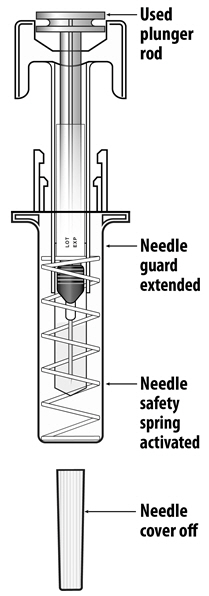 |
Important: The needle is covered by the needle cover before use. |
Important
Read the Patient Information for important information that you need to know about NYVEPRIA before using these Instructions for Use.
Before you use a NYVEPRIA prefilled syringe, read this important information. |
| Storing the prefilled syringe | |
- •
- Store NYVEPRIA in the refrigerator between 36°F to 46°F (2°C to 8°C).
- •
- Do not freeze. If NYVEPRIA is accidentally frozen, allow the prefilled syringe to thaw in the refrigerator before injecting.
- •
- Do not use a NYVEPRIA prefilled syringe that has been frozen more than 1 time. Use a new NYVEPRIA prefilled syringe.
- •
- Keep the prefilled syringe in the original carton to protect from light or physical damage.
- o
- Take the prefilled syringe out of the refrigerator 30 minutes before use and allow it to reach room temperature before preparing an injection.
- o
- Throw away (dispose of) any NYVEPRIA that has been left at room temperature, 68°F to 77°F (20°C to 25°C), for more than 15 days.
- •
- Keep the NYVEPRIA prefilled syringe out of the reach of children.
|
| Using the prefilled syringe | |
- •
- It is important that you do not try to give the injection unless you or your caregiver has received training from your healthcare provider.
- •
- Make sure the name NYVEPRIA appears on the carton and prefilled syringe label.
- •
- Check the carton and prefilled syringe label to make sure the dose strength is 6 mg/0.6 mL.
- •
- You should not inject a dose of NYVEPRIA to children weighing less than 45 kg from a NYVEPRIA prefilled syringe. A dose less than 0.6 mL (6 mg) cannot be accurately measured using the NYVEPRIA prefilled syringe.
- •
- Do not use a prefilled syringe after the expiration date on the label.
- •
- Do not shake the prefilled syringe.
- o
- Do not remove the needle cover from the prefilled syringe until you are ready to inject.
- •
- Do not use the prefilled syringe if the carton is open or damaged.
- •
- Do not use a prefilled syringe if it has been dropped on a hard surface. The prefilled syringe may be broken even if you cannot see the break. Use a new prefilled syringe.
- •
- The prefilled syringe has a needle guard that automatically activates to cover the needle after the injection is given. Do not use a prefilled syringe if the needle guard has been activated. Use another prefilled syringe that has not been activated and is ready to use.
Call your healthcare provider if you have any questions. |
| Step 1: Prepare | |
A. Remove the prefilled syringe carton from the refrigerator.
Remove the inner carton containing the prefilled syringe from the outer carton by peeling away the cover. On a clean, well-lit surface, place the inner carton containing the prefilled syringe at room temperature for 30 minutes before you give an injection. - •
- Do not use the prefilled syringe if the inner carton containing the prefilled syringe is damaged.
- •
- Do not try to warm the prefilled syringe by using a heat source such as hot water or microwave.
- •
- Do not leave the prefilled syringe in direct sunlight.
- •
- Do not shake the prefilled syringe.
Open the inner carton containing the prefilled syringe by peeling away the cover. Grab the needle guard to remove the prefilled syringe from the inner carton containing the prefilled syringe.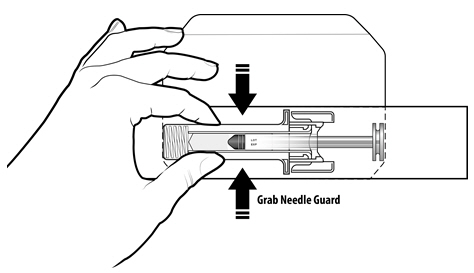 For safety reasons: For safety reasons: - •
- Do not grab the plunger rod.
- •
- Do not grab the needle cover.
B. Inspect the medicine and prefilled syringe.  Make sure the medicine in the prefilled syringe is clear and colorless. Make sure the medicine in the prefilled syringe is clear and colorless. - •
- Do not use the prefilled syringe if:
- o
- The medicine is cloudy or discolored, or contains flakes or particles.
- o
- Any part appears cracked or broken.
- o
- The prefilled syringe has been dropped.
- o
- The needle cover is missing or not securely attached.
- o
- The expiration date printed on the label has passed.
-
- In all cases, use a new prefilled syringe and call your healthcare provider.
C. Gather all materials needed for the injection.
Wash your hands thoroughly with soap and water.
On a clean, well-lit work surface, place the: - •
- Prefilled syringe
- •
- Alcohol wipe
- •
- Cotton ball or gauze pad
- •
- Adhesive bandage
- •
- Sharps disposal container
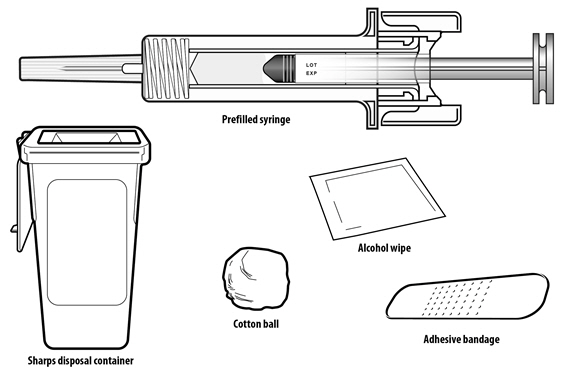 |
| Step 2: Get ready | |
-
- D. Prepare and clean the injection site(s).
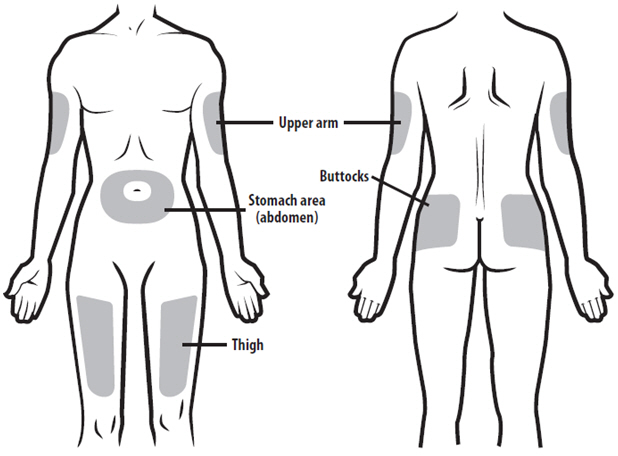 You can use: You can use: - •
- Thigh
- •
- Stomach area (abdomen), except for a 2-inch area right around the navel (belly button)
- •
- Upper outer area of the buttocks (only if someone else is giving you the injection)
- •
- Outer area of upper arm (only if someone else is giving you the injection)
-
- Clean the injection site with an alcohol wipe. Let the skin dry.
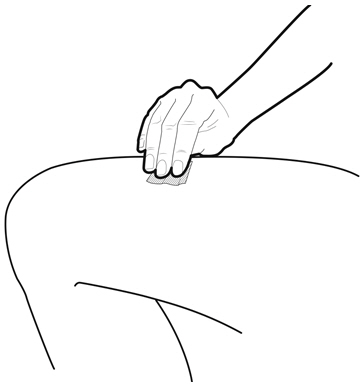 - •
- Do not touch this area again before injecting.
- •
- If you want to use the same injection site, make sure it is not the same spot on the injection site you used for a previous injection.
- •
- Do not inject into areas where the skin is tender, bruised, red or hard. Avoid injecting into areas with scars or stretch marks.
E. Hold the prefilled syringe by the needle guard. Carefully pull the needle cover straight off and away from the body. Throw away the needle cover into the sharps disposal container. Do not recap. 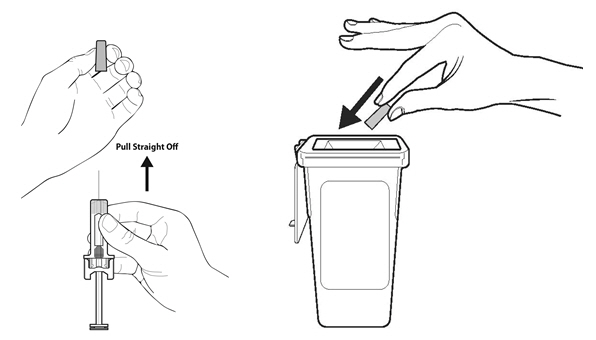 - •
- Do not remove the needle cover from the prefilled syringe until you are ready to inject.
- •
- Do not twist or bend the needle cover.
- •
- Do not hold the prefilled syringe by the plunger rod.
- •
- Do not put the needle cover back onto the prefilled syringe.
Important: Throw the needle cover into the sharps disposal container. |
| Step 3: Subcutaneous (under the skin) injection | |
F. Pinch the injection site to create a firm surface. 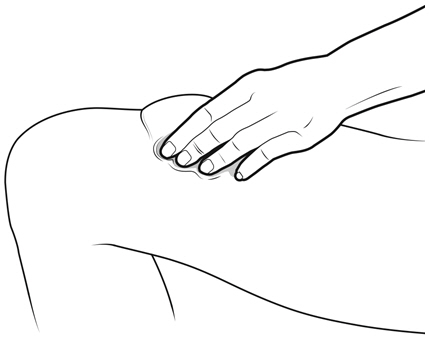 Important: Keep skin pinched while injecting. Important: Keep skin pinched while injecting.
G. Hold the pinch. Insert the needle into the skin at 45 to 90 degrees.  H. Using slow and constant pressure, push the plunger rod down until it reaches the bottom. H. Using slow and constant pressure, push the plunger rod down until it reaches the bottom. 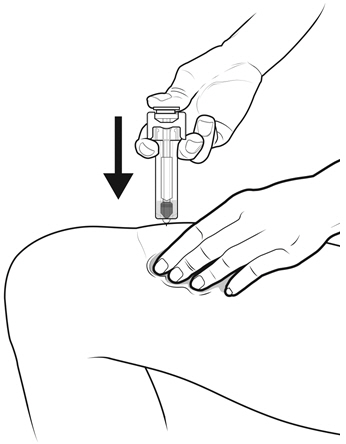 |
| Step 4: Finish | |
| | | |
I. When the syringe is empty, keep the plunger rod fully pressed down while you carefully pull the needle straight out from the injection site and off your skin. 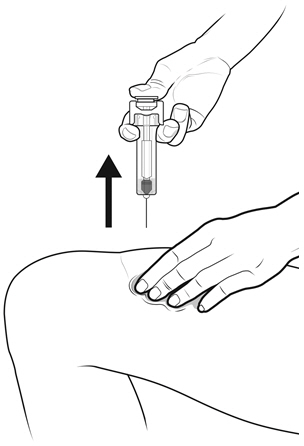 J. Slowly release the plunger rod and allow the syringe needle guard to automatically cover the exposed needle. Do not recap the needle. J. Slowly release the plunger rod and allow the syringe needle guard to automatically cover the exposed needle. Do not recap the needle. Important: When you remove the syringe, if it looks like the medicine is still in the syringe barrel, this means you have not received a full dose. Call your healthcare provider right away. Important: When you remove the syringe, if it looks like the medicine is still in the syringe barrel, this means you have not received a full dose. Call your healthcare provider right away.
K. Examine the injection site.
If there is blood, press a cotton ball or gauze pad on the injection site. Do not rub the injection site. Apply an adhesive bandage if needed.
L. Discard (throw away) the used prefilled syringe. 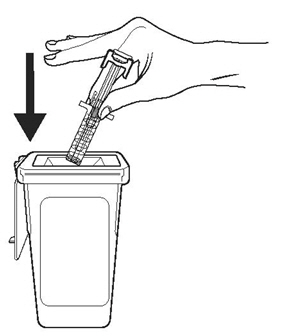 - •
- Put the used prefilled syringe in a FDA-cleared sharps disposal container right away after use. Do not throw away (dispose of) the syringe in your household trash.
- •
- If you do not have a FDA-cleared sharps disposal container, you may use a household container that is:
- o
- made of a heavy-duty plastic,
- o
- can be closed with a tight-fitting, puncture-resistant lid, without sharps being able to come out,
- o
- upright and stable during use,
- o
- leak-resistant, and
- o
- properly labeled to warn of hazardous waste inside the container.
- •
- When your sharps disposal container is almost full, you will need to follow your community guidelines for the right way to dispose of your sharps disposal container. There may be state or local laws about how you should throw away used needles and syringes. For more information about safe sharps disposal, and for specific information about sharps disposal in the state that you live in, go to the FDA's website at: http://www.fda.gov/safesharpsdisposal.
- •
- Do not reuse the prefilled syringe.
- •
- Do not recycle the prefilled syringe or sharps disposal container or throw them in the household trash.
-
- Important: Always keep the sharps disposal container out of the reach of children.
This Instructions for Use has been approved by the U.S. Food and Drug Administration.
Manufactured by
Hospira, Inc., a Pfizer Company,
Lake Forest, IL 60045 USA
US License No. 1974
Distributed by Pfizer Labs, division of Pfizer Inc., New York, NY 10001 USA
 For more information go to www.pfizer.com or call 1-800-438-1985.
LAB-1188-3.0
Issued: March 2023 |